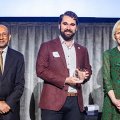UQ zero gravity research facility one of five in the world
A major research facility capable of producing a microgravity environment is being established at the University of Queensland.
One of only five such ground-based facilities in the world, the 30-metre microgravity drop tower will be built at the University's Mechanical Engineering Department and allow around two seconds of microgravity conditions per drop test.
According to Department senior lecturer and project leader Dr Ted Steinberg, the ability to conduct experiments in a conditions of reduced or no gravity is of great interest to engineers and scientists as it allows tests in an environment free of the effects of buoyancy or induced mixing.
"Scientists from the Asia-Pacific region and from all over the world will be able to conduct preliminary tests at our facility before going on to longer durations of microgravity if necessary. These other facilities provide up to 25 seconds of test time, and include NASA's KC135 aeroplane at a cost of around US$45,000 a week (depending on the number of researchers)," Dr Steinberg said.
A principal scientist with Lockheed at NASA White Sands Test Facility for nine years before joining the University, Dr Steinberg has free access to equipment and facilities such as the KC135 aeroplane worth a significant amount in facility support provided directly from NASA. He regularly conducts experiments at NASA's White Sands Test Facility in Las Cruces, New Mexico and the NASA Johnson Space Center in Houston, Texas, with his fellow researchers Joel Stoltzfus (NASA White Sands Test Facility Laboratories Program Manager) and Dr Carl Wright (Technical Lead Supervisor).
A combustion apparatus designed and built by Dr Steinberg and Mr Stoltzfus is flown on the KC135 to test the burning characteristics of a variety of metals such as iron, steel, aluminium and titanium. "These experiments provide performance results and insights into the burning phenomena for metals used for many industrial applications including SCUBA systems, oxygen tanks, air separation plants, welding regulators, and even several international space station components. A thorough knowledge of their potential flammability is vital to ensure human safety and safe operating conditions exist within these systems," Dr Steinberg said.
The metals combustion project was recently recognised as a flagship NASA project with a special issue badge for the suits worn by researchers on the KC135. Colloquially known as the "vomit comet", the KC135 achieves microgravity by flying a parabolic trajectory from an altitude of 35,000 feet to an altitude of 15,000 feet (and then back again) in 25 seconds.
Several of Dr Steinberg's undergraduate and postgraduate students have visited the NASA White Sands Test facilities for their research including Gwenael Chiffoleau, Renee Corrick, Amanda Robbins and John DeWit. NASA is currently funding several aspects of this joint research work.
For more information, contact Dr Ted Steinberg (telephone 07 3365 4155)



